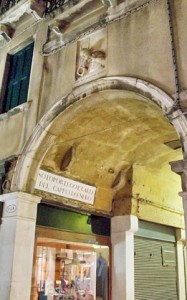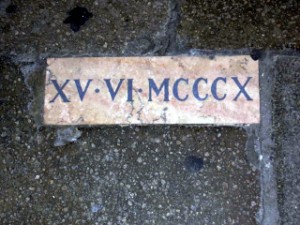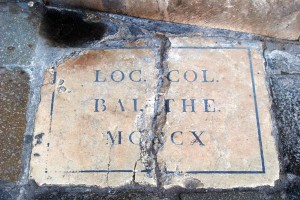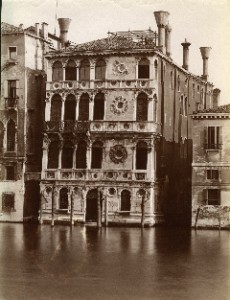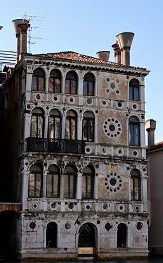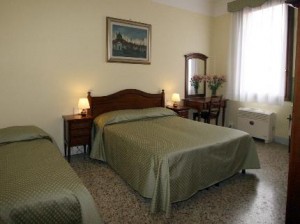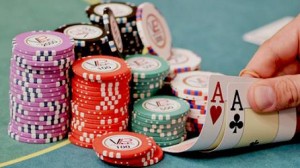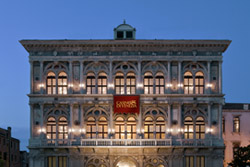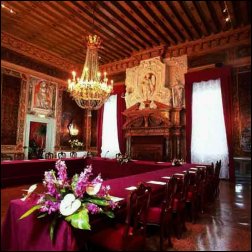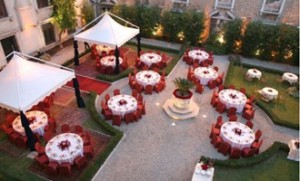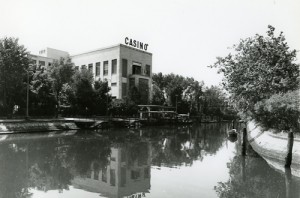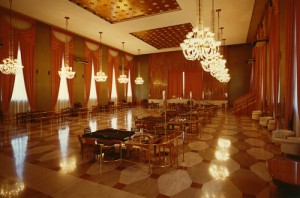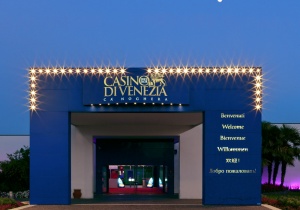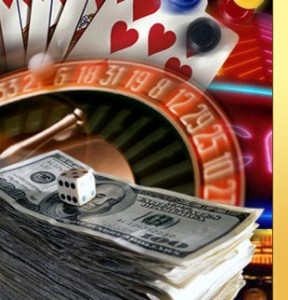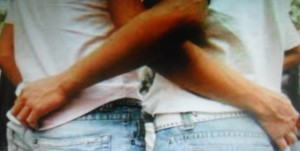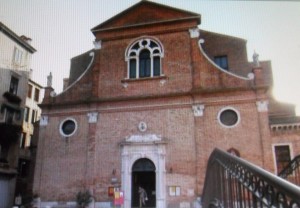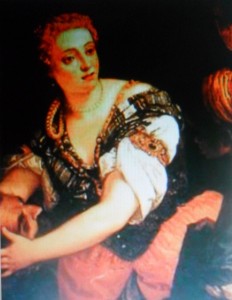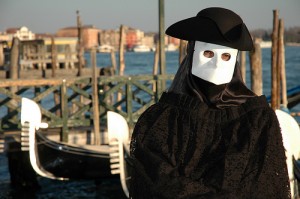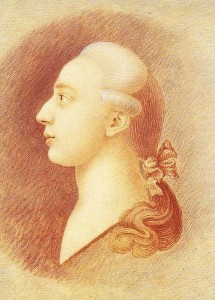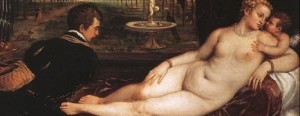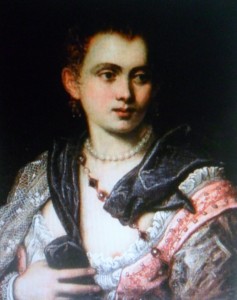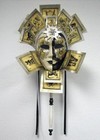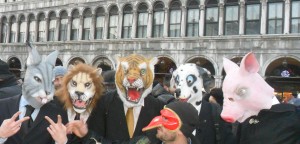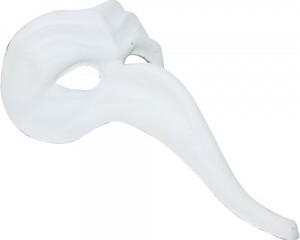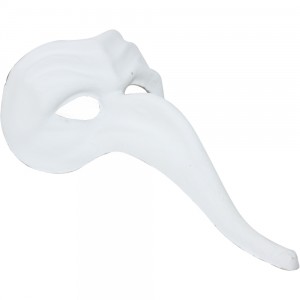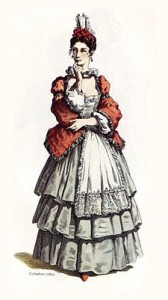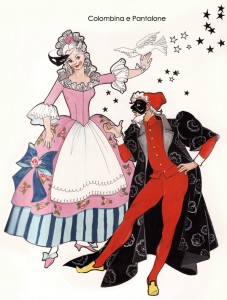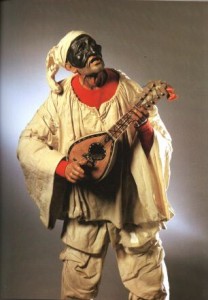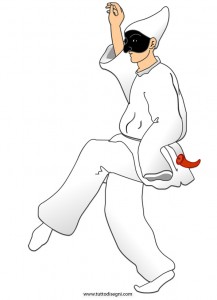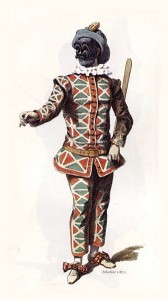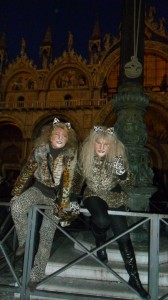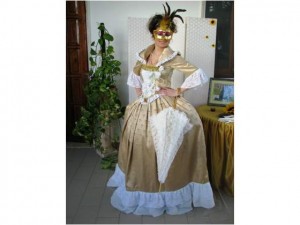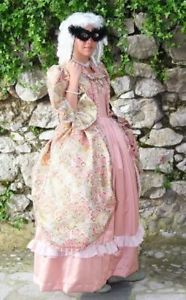Venice, St. John and St. Paul
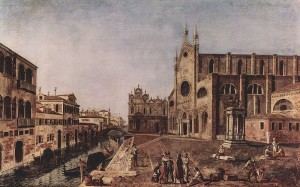 Campo San Giovanni e Paolo (Saints John and Paul), also called the Campo delle ‘Meravegie ” (wonders ),is an area of the most important monuments of Venice, after only to that of St. Mark.Most important monument, the Basilica of Saints John and Paul ( in Venetian dialect San Zanipolo) is one of the most impressive medieval religious building in Venice. In the “Pantheon of the Doges of Venice,”were buried , since 1300, twenty-five, from one hundred and twenty of the Doges of the Republic, and other important personalities. It is considered “twin” of the church of the Frari ,(size 96 to 40 meters, are almost similar to that of the Frari, built at the same time) with the same triumphant Venetian Gothic style.
Campo San Giovanni e Paolo (Saints John and Paul), also called the Campo delle ‘Meravegie ” (wonders ),is an area of the most important monuments of Venice, after only to that of St. Mark.Most important monument, the Basilica of Saints John and Paul ( in Venetian dialect San Zanipolo) is one of the most impressive medieval religious building in Venice. In the “Pantheon of the Doges of Venice,”were buried , since 1300, twenty-five, from one hundred and twenty of the Doges of the Republic, and other important personalities. It is considered “twin” of the church of the Frari ,(size 96 to 40 meters, are almost similar to that of the Frari, built at the same time) with the same triumphant Venetian Gothic style.
 According to the hagiographic tradition, the two blood brothers John and Paul, Christians, rich and very charitable people, were very prominent in the Roman era.Their martyrdom, realy took place in Rome, a strange thing because there are very few Christians,martyrs in Rome. The Emperor Julian, also known as “the Apostate”,despite that initially issued an “Edict of Tolerance ” for Christians especially , he decided to restore the pagan worship. (some say he actually tried to enter possession of the property entrusted to them by Constantina, daughter of Constantine the Great.)
According to the hagiographic tradition, the two blood brothers John and Paul, Christians, rich and very charitable people, were very prominent in the Roman era.Their martyrdom, realy took place in Rome, a strange thing because there are very few Christians,martyrs in Rome. The Emperor Julian, also known as “the Apostate”,despite that initially issued an “Edict of Tolerance ” for Christians especially , he decided to restore the pagan worship. (some say he actually tried to enter possession of the property entrusted to them by Constantina, daughter of Constantine the Great.)
According to legend, the origins of the church are connected to a vision of the Doge Jacopo Tiepolo.
“One night the Doge Jacopo Tiepolo saw in a dream the oratory of S. Daniel and the swampy area full of beautiful flowers on which flying white doves with golden cross on their front. Suddenly two angels descended from heaven with censers exhaling sweet scents .He heard a voice who said: “This is the place i chose for my Preachers.”
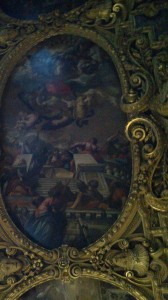 The next day he got the support from the Senate to give the convent (Oratorio di San Daniele) to the Dominican monks, present in the city since more than ten years, and who still lived under the portico of St. Martin. Immediately (1234) will start construction (which remains only the lower part of the façade), dedicated to the Roman martyrs of the fourth century John and Paul.
The next day he got the support from the Senate to give the convent (Oratorio di San Daniele) to the Dominican monks, present in the city since more than ten years, and who still lived under the portico of St. Martin. Immediately (1234) will start construction (which remains only the lower part of the façade), dedicated to the Roman martyrs of the fourth century John and Paul.
The church was solemnly consecrated, almost two centuries after its foundation, November 14, 1430,and was continuously enriched, for almost a century, of sepulchral monuments, paintings, sculptures and works of the greatest Venetian artists.
(martyrs)
He tried to persuade them to renounce their Christian faith , thinking that their reputation
will convince many people to follow their example. Both brothers refused the invitation and Julian sent them the captain of the guard Terenziano, with the injunction to worship the idol of Jupiter.Persisting their refusal, they were seized in the house for about ten days, in order to reflect on the consequences of their refusal.
 The exterior is very simple, and curiously without a bell tower, which seems missing since ‘300. The church has a very high tripartite facade, opened by a central rose window and two “eyes”on the sides .The portal, adorned with six columns of marble transported here in 1459.The autors of this work are Bartolomeo Bono and the master Domenico Fiorentino. On the side of the field there are various buildings and chapels.
The exterior is very simple, and curiously without a bell tower, which seems missing since ‘300. The church has a very high tripartite facade, opened by a central rose window and two “eyes”on the sides .The portal, adorned with six columns of marble transported here in 1459.The autors of this work are Bartolomeo Bono and the master Domenico Fiorentino. On the side of the field there are various buildings and chapels.
The plant is Latin cross with three naves , supported by huge columns , formed by the
union of very thin cylindrical columns.
The statues of the two patrons John and Paul are in the altar.
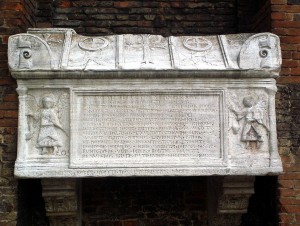 On the walls of the aisles are adjacent monuments, and on the right are the open chapels. In 1682, to better perform massive official events (for example, the funeral of the Doges) the choir,enclosed in the first four columns of the nave was demolished and partly transported to the presbytery.
On the walls of the aisles are adjacent monuments, and on the right are the open chapels. In 1682, to better perform massive official events (for example, the funeral of the Doges) the choir,enclosed in the first four columns of the nave was demolished and partly transported to the presbytery.
(martyrs)
After ten days, (June 26 ,362) the captain, returned to their home, and after three hours of unnecessary threats and blandishments, had beheaded and buried them in a pit dug in the same house, spreading the word that they had been exiled.
After their death, the son of Terenziano, fell prey to an obsession and shouting that John and Paul were tormenting him. The father with great concern, led him on the grave of the two martyrs, where the boy got the cure.
At the death of the Doge , the eldest of the adviser responded :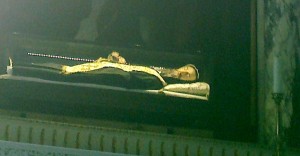
“With much regret we heard of the death of the Most Serene Prince of so much goodness and piety,but we’ll make another one. ”
Then death was announced to the entire city by the “double ring to nine times” of the bells of the churches .The doge was immediately embalmed and wrapped in the cloak of gold, with the Doge’s horn on his head,golden spurs shod down and the sword with the handle towards the foots.The third day after his death, took place a procession attended by thousands of person. Inside the church were finished the funeral prayer ,and everyone turned away in a gondola. http://dipoco.altervista.org/venice-gondola/
The people did not participate much to the doge’s funeral , perhaps because according to an ancient prophecy , the church would have collapsed “on the day of a solemn function” .
Each monument of this basilica tells a page of Venetian history ,from John Dolfin of the twelfth century , one of the oldest graves of the Basilica ,
to the monument to Victor Pisani , ( with the original statue of the deceased ) that recalls the triumph over Genoa in the decisive Battle of Chioggia ( 1380) ,
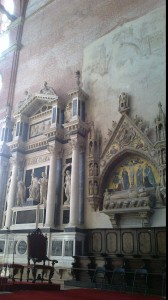 -Jacopo Tiepolo [Duke of Candia (Crete today) and twice bailo (ambassador) in Constantinople], the forty Doge of Venice from March 6, 1229 to May 2, 1249 when he abdicated and retired to private life,
-Jacopo Tiepolo [Duke of Candia (Crete today) and twice bailo (ambassador) in Constantinople], the forty Doge of Venice from March 6, 1229 to May 2, 1249 when he abdicated and retired to private life,
-the urn of the Doge Renier Zen (or Reniero Zeno) forty-fifth Doge of Venice from 1253 to 1268,
-the fourteenth-century tomb of Marco Giustiniani of Bragora,
Alvise-Diedo monument, a member of the Council of Ten, who brought back from Constantinople the Venetian fleet locked by Muhammad in the bay (1453)
-the great Doge Leonardo Loredan the seventy-fifth Doge of Venice, (October 2, 1501 -21 June 1521) ready to shield with his body against the mortal danger that Venice had from the League of Cambrai (1508)
http://www.britannica.com/EBchecked/topic/90599/League-of-Cambrai
– monument to Marcantonio Bragadin , Venetian hero flayed alive by the Turks , contains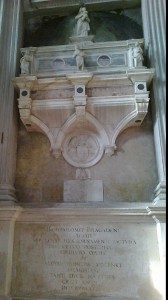
the remained of the skin of the Venetian hero , preserved in an urn , and the bust of the ” greatest hero of the Serenissima” , reminds us of the siege and fall of Famagusta (1571) ;
http://dipoco.altervista.org/venice-martyrdom-bragadin/
The great battle of Lepanto, is commemorated in the monument of the official Lordship :
( Chapel of Our Lady of the Rosary) , where are the remains of Sebastiano Venier , Admiral, winner of Lepanto , elected doge the age of 81 .It was the eighty-sixth Doge of Venice from 11 June 1577-3 March 1578 .
In the Horse’s Chapel, houses the tombs of the ducal family of Francesco and Sebastiano
Venier and fifteenth-century monument to the Doge Antonio Venier ( October 21, 1382 -23 November 1400 ), the sixty-second Doge of Venice.
– the monuments, of Istrian stone , to the Doge Alvise I Mocenigo, Giovanni Mocenigo ( the seventy-second Doge of Venice) , and Pietro Mocenigo ( the seventieth Doge of Venice) , the sepulchres of the doge Alvise I ,Alvise III Sebastian, Alvise IV Giovanni of the wellknown family Mocenigo,
– tomb of the Doge Andrea Vendramin , ( March 4, 1476 May 5, 1478 ) was the seventy-first Doge of Venice. On the sides niches there are two statues of ” Armed men ” , by Lorenzo Bregno.The two statues came to replace Adam (signed by Tullio ) and Eve ( probably by Francesco Segala ), very rare in the funeral art but unsuitable for their nakedness. The statues removed ended at Palazzo Vendramin Calergi , where they became the property of the Duchess of Berry , Adam was then sold to Collections Dreyfus and Pereire finishing first in Paris and then at the Metropolitan Museum of Art in New York. Eva is still at Ca ‘ Vendramin . http://dipoco.altervista.org/the-casino-of-venice/
(martyrs)
The successor of Julian the Emperor Jovian (363-364), repealed the persecution against the Christians, and commissioned the Bizante senator, and his son Pammachius to search for the bodies of two brothers, Once found, the same senator and Pannachio, his son,erected a basilica above their home in the 398.
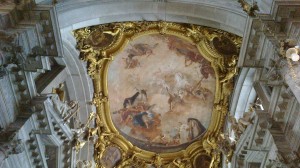 -monument to the Doge Nicolo Marcello, Doge of Venice (August 13, 1473 -1 December 1474) by Pietro and Tullio Lombardo, built between 1481 and 1485.The Doge Nicolo Marcello coined a new currency: the silver sixpence called, not surprisingly, “marcello.” With no direct descendants, he left much of his inheritance to the poors.He died on December 1, 1471, attending the procession to the transfer of the command of the Venetian fleet to Antonio Loredan.
-monument to the Doge Nicolo Marcello, Doge of Venice (August 13, 1473 -1 December 1474) by Pietro and Tullio Lombardo, built between 1481 and 1485.The Doge Nicolo Marcello coined a new currency: the silver sixpence called, not surprisingly, “marcello.” With no direct descendants, he left much of his inheritance to the poors.He died on December 1, 1471, attending the procession to the transfer of the command of the Venetian fleet to Antonio Loredan.
http://en.wikipedia.org/wiki/Nicol%C3%B2_Marcello
-monument to the Doge Tommaso Mocenigo, Doge of Venice sixty-fourth (January 7, 1414 – April 4, 1423) made in the first half of the fifteenth century, combines Gothic Renaissance elements, in addition to denote a certain influence of Donatello. Here it was used for the first time in the canopy fabric.
– the urn of Doge Giovanni Dolfin , elected doge , after the death of Giovanni Gradenigo , August 13, 1356 – ? 1361.
– monument to the Doge Marco Cornaro or Corner – the fifty-ninth Doge of Venice July 21 1365-13 January 1368 .
– monument to the Doge Pasquale Malipiero , sixty-sixth Doge of Venice from October 30, 1457 -7 May 1462 ,by Peter Lombard ,
The Doge Silvestro Valier . He was the last doge buried in the Basilica around 1700.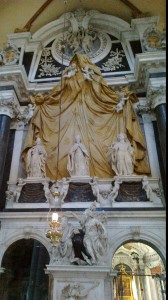
They are buried here also Attilio and Emilio Bandiera and Domenico Moro , the protagonists of the Risorgimento.
http://www.britannica.com/EBchecked/topic/1345637/Bandiera-brothers
On the altar of the chapel of Blessed James Salomoni , or the Name of Jesus , is preserved body of Blessed James Salomoni Dominican (Venice , 1231 – Forlì , 1314 ) , invoked to protect tumors .The vault is adorned with paintings of John the Baptist Lorenzetti and Pietro Liberi . Canova considered it ” a real gem of art.”
Even Palma il Giovane erected here a monument for himself, his father Palma Vecchio and Titian.
(martyrs )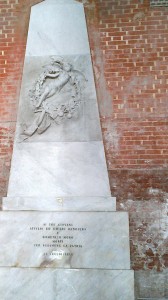
Under the Basilica of Saints John and Paul Celimontana , hidden among medieval arches and buttresses of the path of the Imperial Forums ,have been found , in 1887, the remains of a Roman villa (two floors) inhabited by Christians , with the small compartment of the ” confession ” that bears frescoes of scenes of martyrdom , witnessed by innumerable quotations in Canons both Roman and Ambrosian , language under which there is a mass grave for the burial of two bodies.
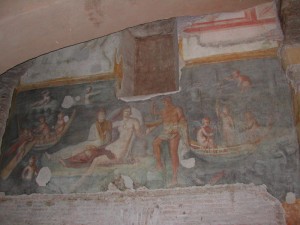 The back wall of the right transept is dominated by a magnificent Gothic window with stained glass , beautifully lighted , completed by Gian Antonio Licino Lodi. By the end of the fifteenth century the glass factories of Venetian island of Murano , employing techniques to get the glass and raw materials.
The back wall of the right transept is dominated by a magnificent Gothic window with stained glass , beautifully lighted , completed by Gian Antonio Licino Lodi. By the end of the fifteenth century the glass factories of Venetian island of Murano , employing techniques to get the glass and raw materials.
To color the glass is added to the crucible of the oxides of manganese for (purple), cobalt (blue), copper ( aquamarine , green and red ) and iron ( yellow, green) . The final color depended on the conditions and the manner in which the merger was conducted .
Below the window you can see two Renaissance altars: one on the right is adorned alms of St. Antonino, altarpiece painted in 1542 by about Lorenzo Lotto, the left by Christ between Sts Peter and Andrew, by Rocco Marconi. At the center, under a canopy, is preserved the chair of the Doge.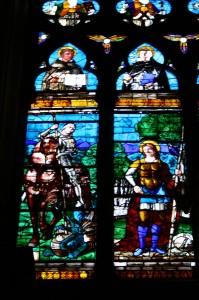
(martyrs)
It is possible that the data , the time and place in which some martyrs died can not be determined with absolute accuracy, but it is certain that the true love of Christ, has helped many Christians to choose a death that will lead to the “eternal life” instead of a life “like a dead.”
Some works that speak of the Italian Renaissance , and the Venetian one in particular can be found : In the chapels of the right side , with gilded wooden ceiling of Tintoretto and Palma il Giovane, with paintings by Titian ” Martyrdom of St. Peter” and ” Madonna and Saints “by Giovanni Bellini, ” the Adoration of the Shepherds “,” Lady of the Assumption and the Annunciation ” by Veronese .In the altar dedicated to St. Vincent, there is a painting by Giovanni Bellini, tempera on panel, dated to 1464-1470 which depicts some miracles of St. Vincent, (dedicated to the Spanish Dominican St Vincent Ferrer, Valencia, January 23, 1350 – Vannes , April 5 1419)
In the chapel of San Domenico, the ceiling fresco by Giovanni Battista Piazzetta . It is the masterpiece of the Venetian rococo at the Basilica of Saints John and Paul.
In the fascinating interior of the basilica are some wonderful paintings of medieval times , including the altarpiece by Lorenzo Lotto , which has influences of Titian,” Jesus Meets Veronica ” by Carlo Caliari , ” St. Michael defeats Lucifer ,” Bonifacio” by Pitati , ” Martyrdom of Santa Cristina ” by Sante Peranda , ” Washing of the Feet and Eucharistic Supper ” by Benedetto Caliari , ” St. Dominic saves the sailors , inviting them to pray the rosary ” by Padovanino , ” Jesus died ” of John the Baptist Zelotti , ” San Francisco, above the door “, Angelo Lion , ” Honorius III ” of Leandro Bassano , in the Chapel of the Rosary, dedicated to the battle of Lepanto in 1571 , are placed works of Paolo Veronese.
In this immense treasure , crucial to Venice you find great monuments of architecture by  Nino Pisano , Peter and Tullio Lombardo , Alessandro Vittoria , Giuseppe Maria Mazza, Gianmaria Morlaiter, Bonazza John ,and masterpieces of painting Giovanni Bellini , Lorenzo Lotto , Cima da Conegliano , Paolo Veronese ,Giambattista Piazzetta …
Nino Pisano , Peter and Tullio Lombardo , Alessandro Vittoria , Giuseppe Maria Mazza, Gianmaria Morlaiter, Bonazza John ,and masterpieces of painting Giovanni Bellini , Lorenzo Lotto , Cima da Conegliano , Paolo Veronese ,Giambattista Piazzetta …
(martyrs )
John and Paul were venerated as saints , and their names were included in the Canon of the Mass .The Catholic Church celebrates the liturgical memorial of them on June 26. Especially in German-speaking countries, but not only, the two saints are considered “Wetterheiligen”, the protectors against storms and, in general, the adverse weather conditions.
In 1806, under the Napoleonic occupation, the Dominicans were removed from their convent, which was turned into a hospital. The church was deprived of numerous works of art. In 1867, a fire completely burns and destroys the Chapel of the Rosary “Madonna and Child with Saints” by Giovanni Bellini (1476) and “The Killing of St. Peter Martyr” by Titian, two works that revolutionized the idea of ” framework for the altar”.
The restoration of this chapel ends in 1959.
Here are the opening hours: daily 7:30 to 12:30 and 15:30 to 19:30
(telephone +39 041 5235913).
The entrance to the Church of San Giovanni e Paolo is free for residents,
the ticket for the tourists is 2.50 €.
other items:http://dipoco.altervista.org/articles/
visit my website http://ginocosta.altervista.org/you-can-do-it.html
On facebook : https://www.facebook.com/pages/Venezia/630678023668582?ref=profile
By : http://dipoco.altervista.org/


